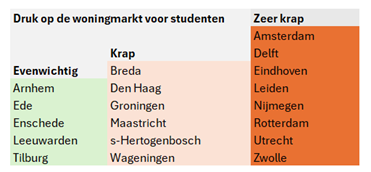Eight years ago, 52 percent of all university of applied sciences and research university students lived in student housing, with another 7 percent wanting to move out that is 59 percent in total. Today, only 44 percent live independently, and just 5 percent are still searching for a room. Combined, that’s 49 percent.
That’s a significant drop compared to eight years ago. According to Kences, the national knowledge center for student housing, students are losing hope of ever finding suitable accommodation.
Consequences
The housing shortage is affecting the accessibility of education, says Kences director Jolan de Bie. Sometimes the program of your choice is simply too far away to stay living at home. What do you do if you can’t find a place to live?
She also fears that students living at home are missing part of the social and emotional development “that is crucial at this stage of life.” These students may feel partly excluded from student life, which could in turn harm their self-esteem, De Bie warns.
Causes
There are several reasons for the shortage. Around five thousand new student rooms were built last year, but the private rental market went in the wrong direction. The number of students renting privately has dropped by 17,800.
Various organizations are sounding the alarm: new laws and regulations protect tenants against exorbitant rents and increase taxes for landlords. As a result, many owners are selling their student houses.
Differences between cities
The nineteen student cities together offer about 322,400 student rooms. That’s roughly 13,500 fewer than in the 2023–2024 academic year.
In five of the 19 cities—Arnhem, Ede, Enschede, Leeuwarden, and Tilburg—student housing shortages are relatively mild. In the other cities, pressure is high or even very high, according to the monitor.
Flexible versus permanent
Researchers also examined where student housing is ‘structural,’ meaning always intended for students, and where it’s ‘flexible,’ meaning that students are living in housing that might be rented to someone else next time or could disappear altogether.
In The Hague, Amsterdam, and Den Bosch, the flexible supply is larger than the structural supply. In Rotterdam it’s evenly split, while in other cities structural housing dominates. A stable supply makes students less vulnerable, the monitor notes.
International students
The shortage is also linked to the arrival of international students. De Bie warns that attracting global talent becomes more difficult if these students can’t find housing. “Neighboring countries often can guarantee accommodation, which puts the Netherlands at a growing competitive disadvantage.”
Some political parties argue that the solution lies in reducing the number of international students. Critics counter that, given labor market shortages, this could ultimately harm the knowledge economy.
Possible solutions
What else might help? Kences suggests more flexible municipal rules on shared housing. In some cases, the argument of preventing nuisance should weigh less heavily than the housing crisis. Temporary rental contracts for students should also be allowed again.
The current shortage of student rooms is 21,500. That figure reflects the gap between supply and demand—excluding students who have stopped searching altogether and excluding MBO students.
Looking ahead
If trends continue, the shortage could rise to between 26,000 and 63,000 rooms by the 2032–2033 academic year. While the number of Dutch students is expected to decline and international enrollment is barely increasing, the private rental supply is shrinking even faster.
The National Student Housing Monitor is carried out by ABF Research, commissioned by Kences and the Ministry of Housing and Spatial Planning.
This article was translated using AI-assisted tools and reviewed by an editor.




Discussion